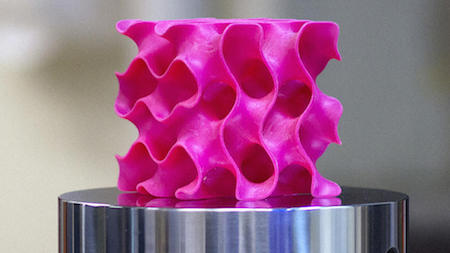Science Fiction
Dictionary
A B C D E F G H I J K L M N O P Q R S T U V W X Y Z
Reconfigured Graphene 10X Strong, 5 Percent Dense, As Steel

Industrious MIT researchers have created a reconfigured graphene, a porous material ten times stronger than steel, and yet only 5% as dense.

(Reconfigured graphene)
The material is composed of graphene, a two-dimensional form of carbon that's considered to be the strongest of all known materials. But because the 2D form of graphene is so thin—it's only one atom thick—it's impractical for building purposes. The team's breakthrough is in creating a 3D geometry out of graphene using a combination of heat and pressure.As detailed in a paper published today in the journal Science Advances, they developed computational models of the form and then recreated it with graphene. The kicker? During testing, they found that the samples of the porous material were ten times stronger than steel, even though they were only 5% as dense...
But Qin believes that the potential applications for the material aren't limited to buildings on Earth. It's in shipping supplies into space to build space stations, or even colonies, that such a lightweight building material could dramatically reduce costs.
I love science-fictional materials, so naturally I'm reminded of alohydrolium, the lightest of all metals, introduced by Hugo Gernsback in his 1911 scientifiction classic Ralph 124c 41 +.
Of course, it's a popular idea. You might want to take a look at helio-beryllium from Out Around Rigel (1931) by Robert H. Wilson, sodaluminum from Exiles of the Moon (1931) by Nat Schachner (w. AL Zagat) and harbenite from Tarzan at the Earth's Core (1929) by Edgar Rice Burroughs. And don't forget nothing from It was Nothing - Really! (1969) by Theodore Sturgeon.
Update 08-Jan-2017: Ultralight materials were a staple in the architectural visions of scientifiction writers like A.G. Stangland, writing in The Ancient Brain in 1929:
Out of respect for my natural wonderment, Jak pointed out to me and explained the ultra-modern objects of my interest. The buildings were constructed of an alloy metal which was extremely strong and light in mass. It had made possible the graceful sweeping finish of the skyscrapers, which seemed to have an average height of twenty stories. Between the towering masses of metal stretched spidery suspension pathways, the sidewalks of which were moving, thus transporting pedestrians.
End update.
Via Fastcodesign. Thanks to David Brin who tweeted about this material.
Scroll down for more stories in the same category. (Story submitted 1/3/2017)
Follow this kind of news @Technovelgy.| Email | RSS | Blog It | Stumble | del.icio.us | Digg | Reddit |
Would
you like to contribute a story tip?
It's easy:
Get the URL of the story, and the related sf author, and add
it here.
Comment/Join discussion ( 0 )
Related News Stories - (" Material ")
Harvard Metamaterials Change Structure Instantly
'Annealed in any shape for a time, and codified, the structure of that shape is retained down to the molecules.' - Samuel R. Delany
Nano-Chainmail 2D Mechanically Interlocked Polymer
'Nemourlon armor of reasonable weight resists penetration by most fragments and any bullet that is not both reasonably heavy and fairly high-velocity.' - Jerry Pournelle, 1976.
Goldene - A Two-Dimensional Sheet Of Gold One Atom Thick
'Hasan always pitched a Gauzy - a one-molecule-layer tent, opaque, feather-light, and very tough.' - Roger Zelazny, 1966.
FlexRAM Liquid Metal RAM And One Particular SF Movie Robot
'Its lines wavered, flowed, and then painfully reformed.' - Philip K. Dick, 1957.
Technovelgy (that's tech-novel-gee!) is devoted to the creative science inventions and ideas of sf authors. Look for the Invention Category that interests you, the Glossary, the Invention Timeline, or see what's New.
Science Fiction
Timeline
1600-1899
1900-1939
1940's 1950's
1960's 1970's
1980's 1990's
2000's 2010's
Current News
The Zapata Air Scooter Would Be Great In A Science Fiction Story
'Betty's slapdash style.'
Thermostabilized Wet Meat Product (NASA Prototype)
There are no orbiting Michelin stars. Yet.
Could Crystal Batteries Generate Power For Centuries?
'Power could be compressed thus into an inch-square cube of what looked like blue-white ice'
India Ponders Always-On Smartphone Location Tracking
'It is necessary... for your own protection.'
Amazon Will Send You Heinlein's Knockdown Cabin
'It's so light that you can set it up in five minutes by yourself...'
Is It Time To Forbid Human Driving?
'Heavy penalties... were to be applied to any one found driving manually-controlled machines.'
Replace The Smartphone With A Connected Edge Node For AI Inference
'Buy a Little Dingbat... electropen, wrist watch, pocketphone, pocket radio, billfold ... all in one.'
Artificial Skin For Robots Is Coming Right Along
'... an elastic, tinted material that had all the feel and appearance of human flesh and epidermis.'
Robot Guard Dog On Duty
I might also be thinking of K-9 from Doctor Who.
Wearable Artificial Fabric Muscles
'It is remarkable that the long leverages of their machines are in most cases actuated by a sort of sham musculature...'
BrainBridge Concept Transplant Of Human Head Proposed
'Briquet’s head seemed to think that to find and attach a new body to her head was as easy as to fit and sew a new dress.'
Google's Nano Banana Pro Presents Handwritten Math Solutions
'...copy was turned out in a charming and entirely feminine handwriting.'
Edible Meat-Like Fungus Like Barbara Hambly's Slunch?
'It was almost unheard of for slunch to spread that fast...'
Sunday Robotics 'Memo' Bot Has Unique Training Glove
'He then started hand movements of definite pattern...'
Woman Marries Computer, Vonnegut's Dream Comes True
'Men are made of protoplasm... Lasts forever.'
Natural Gait With Prosthetic Connected To Nervous System
'The leg was to function, in a way, as a servo-mechanism operated by Larry’s brain...'
